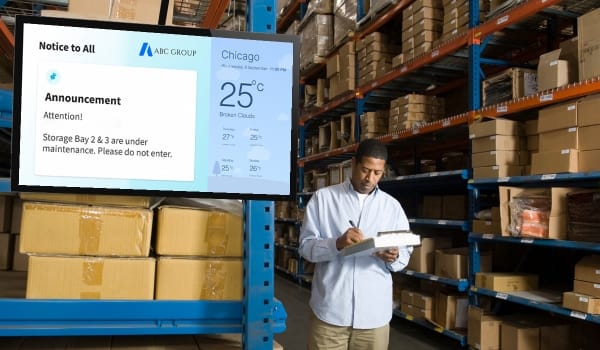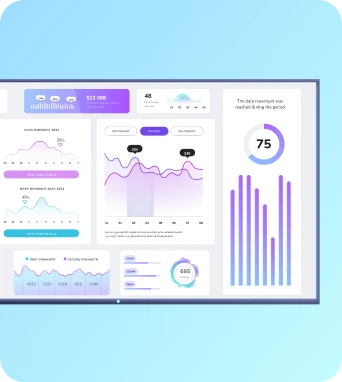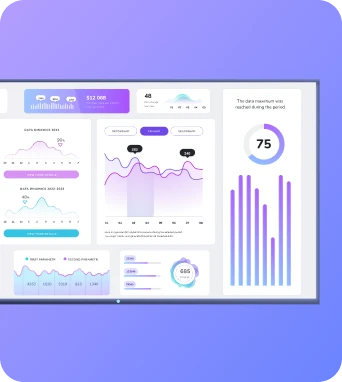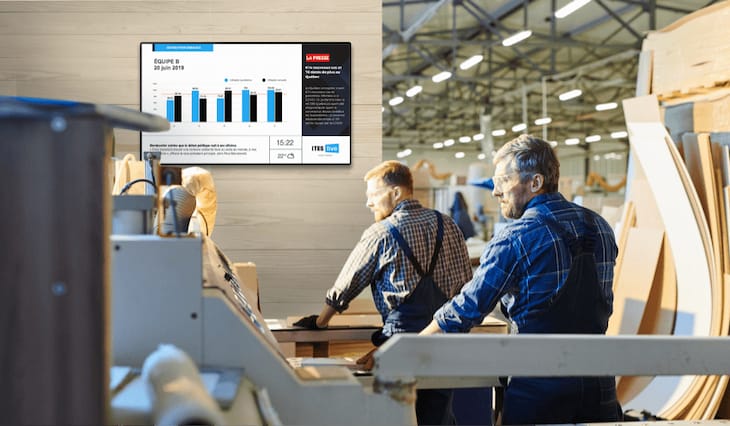AI and touchscreens and OLEDs, oh my! 2023 was a wild year for digital signage. But now that we’ve crossed into 2024, we’re all wondering what to expect in the months ahead.
At Fugo, we’re all about celebrating signage trends and helping businesses make the most of their digital displays. And take it from us: there’s a lot to be excited about in 2024, no matter where you’re at in your signage journey.
This guide has us looking at the biggest digital signage trends of 2024 so your team can get ahead of the curve. There’s no guarantee we’ll be 100% accurate with our predictions, but we’ll show you the numbers so you can make informed decisions yourself.
Digital signage trends for 2024
What can we expect from signage this year?
If it’s anything like last year, get ready for curveballs.
Even if we can’t predict tomorrow with 100% accuracy, we can make an educated guess about what the future may hold.
Let’s start with one of the developments we’re really looking forward to:
1. More Soli ATAP research
Our interactions with digital signage are slowly becoming more human. Not just because we’re getting used to interfacing with technology, but because more and more research is uncovering new opportunities.
Soli ATAP research (AKA Google's Advanced Technology and Products division) has been hard at work developing new features for digital signage. This includes equipping screens with radar capabilities so they can understand human activities and respond to stimuli.
When screens notice people moving into their ‘personal space,’ they trigger a series of events to make our lives a little easier. In a business context, this could mean:
- Starting a pre-programmed video when a customer walks towards the screen
- Pulling up touch controls if a person enters a certain proximity or radius
- Tracking eye movements to trigger buttons, videos, or perform other actions
Soli research is still in its early phases, and it’s not likely to become mainstream for all digital signage platforms. . . yet. But there’s a good chance we’re going to hear more from Google ATAP Division as we soar into 2024.
If you’re curious to see ATAP tech in action, check out this recent demo below:
2. Greater engagement for deskless workers
Traditional signage was built for traditional workers, like stationary employees in cubicles or workstations. But there’s change on the wind for 2024 — and it’s finally giving a nod to the deskless worker.
More than a third of the entire US workforce consists of deskless workers. This includes nurses, pilots, teachers, and even grocery store employees serving on the front lines.

Deskless workers are traditionally underserved by digital signage and often lack communication consistency from other departments and higher-ups. This year, however, we’re predicting a change — starting with:
- Segmenting screens to display different information in different environments
- QR codes to disseminate lots of information quickly (more on this later)
- Targeted content for local offices, branches, or subsidiaries
- Scheduled content to suit various shifts (since first-shift teams may need a different set of content than second or third-shift teams)
Just look at how Costco built greater employee engagement by upgrading their existing digital signage program. During the pandemic, they realized they needed to communicate health and safety information in a faster, safer, and more engaging way.
The company primarily focused on break rooms as the place to roll out their digital signage campaign. Not only did they notice an uptick in engagement, but they clearly and consistently communicated information across multiple locations. A win-win for everyone!
If you want to hop on the bandwagon with deskless workers and digital signage, you can check out our whitepaper here for more details.
3. Growing interest In E-Paper displays
Ever used a Kindle? Then you’re familiar with e-paper. And while it’s never been a viable option for wide-scale digital signage before, it’s slowly becoming a potential candidate for larger applications and full-color displays.
The e-paper industry may grow at a CAGR of 17.1% between 2023 and 2032, and is set to reach $11.6 billion by the end of that year. E Ink, the parent company of e-paper, also debuted its first full color 32-inch display this year, marking the beginning of a new era for the digital signage industry.
More e-paper displays mean more sustainable infrastructure, as well as better viewing experiences for customers walking outside. There’s also far less complicated wiring involving, which makes e-paper the perfect solution for grocery stores, airports, bus terminals, and more.
We wrote a more in-depth guide to e-paper signage here.
4. TV Dashboards are all the rage
Just one in four companies in 2023 used business intelligence data. This number has remained stagnant for nearly 25 years, but in 2024, it’s finally set to break the barrier.
BI platforms have made it easier than ever to build customizable dashboards and show off key metrics. Self-service options also make TV dashboards a breeze so you can build and display data for even the busiest front-line workers.
You (thankfully) don’t need a cloud platform to get involved in the TV dashboard trend. Fugo offers an on-premise TV dashboards solution to help you democratize data internally.
Check out the nitty-gritty details here:
5. The rise of company TV channels
Remember the PowerPoint displays of yesteryear? Or those screensaver-like images endlessly rotated on your lobby’s TV screen?
Good news: dated displays and slideshows are becoming a thing of the past. Say goodbye to garish carousels, and say hello to company TV channels!
Modern businesses have to work extra hard to keep their hybrid teams informed and in the loop. Company TV channels help with all this and more, with added functionality for on-premise displays and additional support for watching in your browser.
The best part? You can even embed dashboards and reports in company channels to unlock siloed data and keep everyone informed.
How’s that for killing two trends with one stone?
6. Immediate updates will become the norm
The world is changing quickly these days. Read: really, really fast. What’s true one minute may not be true another, which means making immediate updates to your signage becomes more important than ever.
Digital signage tools with faster reflexivity are the best way to do this at scale. In 2024, the ability to monitor and adjust signage from behind a single pane of glass will matter more than ever to the IT heroes of tomorrow.
Fugo is going the extra mile to make this immediacy more accessible to business owners. Since you can find, edit, and save content templates matching your brand identity, you can just log into your account, make a few simple changes, and go live within 15 minutes or less.
7. QR codes are (still) relevant
You read this right — QR codes are back from the dead!
But honestly, they never really left.
Just look at this Google Trends chart from 2019 to 2023. Sure, there’ve been a few ups and downs, but it’s clear the QR code is alive and well.
The sustained success of the QR code is a marvelous premonition of 2024. Take a look at all the new use cases it offers, and you can easily see what we mean — from parking reservations to improving patient care, there’s a lot more to QR than touchless menus these days.
Is your restaurant ready to look at more specifics? Our guide to QR codes covers more than you probably ever wanted to know.
8. AI may (or may not) take center stage
Brace yourself; AI is coming. Frankly, it’s already here.
And if you’re already sick of seeing the word ‘AI’ in your feed, you might want to break out the Dramamine.
AI isn’t taking over the world (yet), but it has caused quite a buzz in the digital signage industry. From display scheduling to content generation, there’s a lot to look forward to on the horizon.
So can we expect an AI-takeover of signage in 2024? That remains to be seen. But you can bet your bottom dollar it will impact some element of your process, whether it’s the data popping up on your TV dashboard or your audience analytics of behavior and engagement.
9. Touch content is hey
We’ve got a pretty good feeling about this upcoming trend — interactive touch contact has been on the rise for years. Not only will the touchscreen market get 2.5 times bigger by 2029, but more and more consumers will demand touch content experiences
When we say touch content, we mean any type of dynamic signage with the purpose of generating user interactivity. This could be browsing virtual catalogs, taking an in-store survey, or even navigating your business with an interactive map.
Touch content can help your business stand out from the crowd and foster deeper engagement with customers. It also comes with unique benefits depending on your industry:
- 73% of travelers are more likely to stay at hotels with self-service technology
- 83% of patients spend time interacting with digital content displayed at a hospital
- 32.8% of customers at retail stores become repeat buyers after engaging with interactive displays
The best part? It doesn’t take much to join the touch content hype train (so long as you have access to touch screen TVs or kiosks). Just look at this recent campaign for #BeMoreFanta — interesting, engaging, and downright inventive.
10. Social media reigns supreme
You don’t need us to tell you social media is on the rise. One look at the numbers says everything you need to know.
There are now more than 4.95 billion social media users worldwide, compared to 2.796 billion just six years earlier. This may grow to six billion in 2027, which as of today, is just three years away.
Interestingly, certain social media platforms are rising above others to take key seats at the table. Even slightly more established platforms with an infamous history (AKA TikTok) skyrocketed to 1.61 billion users in the third quarter of 2023 — a 12% difference compared with the same time in 2022.
This influx of growth means two things for digital signage: that opportunities abound, and that late adopters may get left behind. Embracing social media as a core element of digital signage can engage customers, staff members, and other stakeholders in your business.
For 2024, we expect to see more social media walls used for sales teams, marketing departments, and visiting customers.
We also expect to see walls around front-facing employees. Imagine how fun it would be to push comments on Yammer or Slack to a dedicated in-office screen.
Where Fugo’s going in 2024?
So we’re not actually going anywhere in 2024. But we are making changes to usher in a new age of better digital signage.
If you’ve already skimmed through our 2023 product wrap up, you know we’re prepping for our biggest year yet.
Get ready for:
- New apps and integrations with the tools you’re already using. And yes, we’re being coy on purpose. Stay tuned for more updates!
- A Microsoft Teams bot for automating content posting. If you spend your life scheduling other people’s lives on Teams, this upgrade is for you.
- Riding that Microsoft wave with even more integrations with the Office 365 Suite. We’re planning on rolling out details soon so you have a better idea of what to expect.
- SOC 2 certification for greater peace of mind. Feel free to learn more about our currently available security features like Okta’s SSO and Fugo’s 2FA.
And pssst — you can request additional features and integrations for the Fugo team by submitting a suggestion through the app.
No matter what 2024 may hold, Fugo is here for all of it.
And if you need support or encouragement along the way, just know we’re standing by to help.
Here’s to a marvelous 2024!





